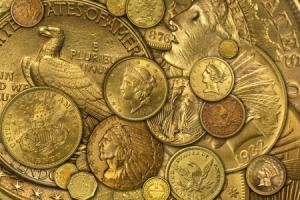Buy Gold Bullion
Many financial experts recommend to invest a certain portion of your assets in gold and other precious metals. Most of these experts recommend to invest about 10% of your assets in this way. That will serve as a hedge against inflation and other economic uncertainties. Historically, whenever the stock market was in turmoil, gold and other precious metal saw their value boosted. Better stay away from paper gold investments (that may or may not be backed by real physical gold) and choose real gold bullion instead. You could even combine your gold investment with saving for your retirement in the form of a Gold IRA. However, an IRA can also include other precious metals and not only gold. This page gives you a short overview of the different choices you have when investing in gold.
Gold Bullion can be bought in the form of gold coins, gold bars and gold rounds. Of those, gold rounds (that look like coins, but don't have a face value) are the least popular option since the choice of different gold rounds is fairly limited. That's why Buy-Gold.Link doesn't offer a specialized section for gold rounds at this point. Most private investors choose to invest in gold coins whereas institutional investors (and large-scale private investors) generally prefer gold bars. When choosing coins over bars, you have a further choice between contemporary gold bullion coins that are still regularly minted (usually every year) and historic gold coins whose mintage run has ended.
After choosing between the three types of gold bullion below, you will come to a page with further information that allows you to select specific gold bullion products that you want to learn more about. These product pages will not only give you all relevant information about the product but also allow you to compare current prices and directly buy the gold coins or bars of your choice from respected gold dealers online.
 Buy Gold Bullion Coins - 22 and 24 karat gold coins
Buy Gold Bullion Coins - 22 and 24 karat gold coins

Gold coins of various levels of purity are produced by government mints worldwide. For a gold coin to be considered bullion, it must be at least 90% pure however. Most gold bullion coins on the market these days are 22 and 24 karat coins. A 22 karat gold coin is 91.67% pure, so 22 out of each 24 parts are gold. The American Gold Eagle coins and the South African Gold Krugerrand coins are such 22 karat gold coins. When 24 out of 24 parts are gold, we speak of 24 karat gold coins. These can be 99.5% pure (which is uncommon these days), 99.9% or 99.99% pure (the vast majority of coins) and even 99.999% pure (the highest gold purity ever achieved so far). The coins are generally offered in a wide variety of sizes/denominations. The 1 oz size is undoubtedly the most common. However, small sizes like 1/20 oz, 1/25 oz or even 1/40 oz, 1 gram and 1/2 gram are minted by some mints. Since these tiny coins are more expensive to produce for the mint, they generally cost much higher premiums. Larger sizes than 1 oz are offered as well with the sizes of 5 oz, 10 oz, 12 oz and 1 kg being fairly common. Some of the larger sizes are sometimes only minted as proof coins in limited numbers. The regular sizes are usually available as both brilliant uncirculated and proof coins with the latter costing a bit more due to their higher value for collectors. The market value of all gold bullion coins is tied to the gold spot price and exceeds their legal tender face value by far.
Click here or on the headline above to learn more about gold bullion coins and find out what the most popular such coins are.
 Buy Historic Gold Coins - including pre-1933 U.S. gold coins
Buy Historic Gold Coins - including pre-1933 U.S. gold coins

This section of Historic Gold Coins lists coins that are no longer minted, no matter whether their mintage run ended a long time ago or fairly recently. The coins all meet bullion criteria as far as their gold purity is concerned (at least 90%). They can not be used as legal tender anymore though. Due to the advanced age of these coins, they may not always be in perfect condition. Dents and scratches as well as red spots are commonly found on such coins. That is why historic gold coins are often cheaper than contemporary gold bullion coins of the same size. Expect to pay a collectibility premium for some rarer historic gold coins though. The majority of the coins that you find in this section are pre-1933 US gold coins like for example the Saint Gaudens Double Eagles. Since many types of historic gold coins were once minted in the millions, they are still briskly traded online and most online gold dealers have a special section for such historic coins. Proof coins are extremely rare though since proof mintage was not as common in the past as it is nowadays.
Click here or on the headline above to learn more about historic gold coins and see the list of coins.
 Buy Gold Bullion Bars - cast and minted bars
Buy Gold Bullion Bars - cast and minted bars

Gold Bullion Bars need to meet the minimum purity standard of 99.5%. That is much higher than the minimum purity for gold bullion coins. If you want to obtain the largest possible amount of gold for your investment amount, gold bars are the way to go. Since these bars are usually not fancy in their design and bear few if any artistic designs, their cost of production is much lower. These lower production cost are passed on to consumers in the form of lower premiums. Many government and private mints worldwide produce gold bars in a variety of sizes ranging from tiny 1 gram gold bars up to 400 oz "Good Delivery" gold bars. Whereas the largest gold bars are intended for the interbank trade, larger-scale private investors commonly choose gold bars in sizes of 100 grams, 5 oz and 10 oz. Gold bars of these sizes are commonly available and cost much lower premiums than smaller gold bars. This section lists the various gold bar products of the four major private producers PAMP Suisse, Valcambi Suisse, Sunshine Minting and Credit Suisse. Additional producers will be added to the page in the future.
Click here or on the headline above to learn more and see the list of gold bar manufacturers.